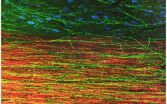Gut microbes browse along a gene buffet
2014-08-07
DURHAM, N.C. -- In the moist, dark microbial rainforest of the intestine, hundreds of species of microorganisms interact with each other and with the cells of the host animal to get the resources they need to survive and thrive.
Though there's a lot of competition in this vibrant ecosystem, collaboration is valued too. A new study on the crosstalk between microbes and cells lining the gut of mice shows just how cooperative this environment can be.
One of the main ways that hosts manage their interactions with microbes is by carefully controlling the genes that their ...
NASA sees Hurricane Julio organize and emit a gamma-ray flash
2014-08-07
NASA's Fermi and Aqua satellites captured two different views of bursts of strength show by Hurricane Julio as it intensified. NASA's Fermi satellite saw a gamma-ray flash from Julio, while NASA's Aqua satellite saw Julio become more structurally organized as a hurricane.
This type of outburst is known as a terrestrial gamma-ray flash (TGF). Produced by the powerful electric fields in thunderstorms, TGFs last only a few thousandths of a second but emit gamma rays that make up the highest-energy naturally-occurring light on Earth. Scientists estimate that, on average, ...
Wild sheep show benefits of putting up with parasites
2014-08-07
In the first evidence that natural selection favors an individual's infection tolerance, researchers from Princeton University and the University of Edinburgh have found that an animal's ability to endure an internal parasite strongly influences its reproductive success. Reported in the journal PLoS Biology, the finding could provide the groundwork for boosting the resilience of humans and livestock to infection.
The researchers used 25 years of data on a population of wild sheep living on an island in northwest Scotland to assess the evolutionary importance of infection ...
NASA sees Genevieve cross international date line as a Super-Typhoon
2014-08-07
Tropical Storm Genevieve had ups and downs in the Eastern Pacific and Central Pacific over the last week but once the storm crossed the International Dateline in the Pacific, it rapidly intensified into a Super Typhoon. NASA-NOAA's Suomi NPP satellite captured of the storm.
When Suomi NPP flew over Genevieve on August 7 at 01:48 UTC the Visible Infrared Imaging Radiometer Suite (VIIRS) instrument aboard captured an infrared image of the storm. VIIRS collects visible and infrared imagery and global observations of land, atmosphere, cryosphere and oceans. VIIRS flies aboard ...
Dramatic growth of grafted stem cells in rat spinal cord injuries
2014-08-07
Building upon previous research, scientists at the University of California, San Diego School of Medicine and Veteran's Affairs San Diego Healthcare System report that neurons derived from human induced pluripotent stem cells (iPSC) and grafted into rats after a spinal cord injury produced cells with tens of thousands of axons extending virtually the entire length of the animals' central nervous system.
Writing in the August 7 early online edition of Neuron, lead scientist Paul Lu, PhD, of the UC San Diego Department of Neurosciences and colleagues said the human iPSC-derived ...
Human skin cells reprogrammed as neurons regrow in rats with spinal cord injuries
2014-08-07
While neurons normally fail to regenerate after spinal cord injuries, neurons formed from human induced pluripotent stem cells (iPSCs) that were grafted into rats with such injuries displayed remarkable growth throughout the length of the animals' central nervous system. What's more, the iPSCs were derived from skin cells taken from an 86-year-old man. The results, described in the Cell Press journal Neuron, could open up new possibilities in stimulating neuron growth in humans with spinal cord injuries
"These findings indicate that intrinsic neuronal mechanisms readily ...
Cancer study reveals powerful new system for classifying tumors
2014-08-07
Cancers are classified primarily on the basis of where in the body the disease originates, as in lung cancer or breast cancer. According to a new study, however, one in ten cancer patients would be classified differently using a new classification system based on molecular subtypes instead of the current tissue-of-origin system. This reclassification could lead to different therapeutic options for those patients, scientists reported in a paper published August 7 in Cell.
"It's only ten percent that were classified differently, but it matters a lot if you're one of those ...
Largest cancer genomic study proposes 'disruptive' new system to reclassify tumors
2014-08-07
Novato, California: Researchers with The Cancer Genome Atlas (TCGA) have analyzed more than 3500 tumors on multiple genomic technology platforms, revealing a new approach to classifying cancers. This largest-of-its-kind study, published online August 7th in Cell featured major contributions by Buck faculty Christopher Benz, MD and Senior Staff Scientist Christina Yau, PhD.
TCGA scientists analyzed the DNA, RNA and protein from 12 different tumor types using six different TCGA "platform technologies" to see how the different tumor types compare to each other. The study ...
University of Minnesota research finds key piece to cancer cell survival puzzle
2014-08-07
An international team led by Eric A. Hendrickson of the University of Minnesota and Duncan Baird of Cardiff University has solved a key mystery in cancer research: What allows some malignant cells to circumvent the normal process of cell death that occurs when chromosomes get too old to maintain themselves properly?
Researchers have long known that chromosomal defects that occur as cells repeatedly divide over time are linked to the onset of cancer. Now, Hendrickson, Baird and colleagues have identified a specific gene that human cells require in order to survive these ...
Notch developmental pathway regulates fear memory formation
2014-08-07
Nature is thrifty. The same signals that embryonic cells use to decide whether to become nerves, skin or bone come into play again when adult animals are learning whether to become afraid.
Researchers at Yerkes National Primate Research Center, Emory University, have learned that the molecule Notch, critical in many processes during embryonic development, is also involved in fear memory formation. Understanding fear memory formation is critical to developing more effective treatments and preventions for anxiety disorders such as post-traumatic stress disorder (PTSD).
The ...
Scientists uncover stem cell behavior of human bowel for the first time
2014-08-07
For the first time, scientists have uncovered new information on how stem cells in the human bowel behave, revealing vital clues about the earliest stages in bowel cancer development and how we may begin to prevent it.
The study, led by Queen May University of London (QMUL) and published today in the journal Cell Reports, discovered how many stem cells exist within the human bowel and how they behave and evolve over time. It was revealed that within a healthy bowel, stem cells are in constant competition with each other for survival and only a certain number of stem ...
Cancer categories recast in largest-ever genomic study
2014-08-07
New research partly led by UC San Francisco-affiliated scientists suggests that one in 10 cancer patients would be more accurately diagnosed if their tumors were defined by cellular and molecular criteria rather than by the tissues in which they originated, and that this information, in turn, could lead to more appropriate treatments.
In the largest study of its kind to date, scientists analyzed molecular and genetic characteristics of more than 3,500 tumor samples of 12 different cancer types using multiple genomic technology platforms.
Cancers traditionally have ...
Scientists uncover key piece to cancer cell survival puzzle
2014-08-07
A chance meeting between two leading UK and US scientists could have finally helped solve a key mystery in cancer research.
Scientists have long known that chromosomal defects occur as cells repeatedly divide. Over time, these defects are linked to the onset of cancer.
Now, Professor Duncan Baird and his team from Cardiff University working in collaboration with Eric A. Hendrickson from the University of Minnesota, have identified a specific gene that human cells require in order to survive these types of defects.
"We have found a gene that appears to be crucial ...
Regulations needed to identify potentially invasive biofuel crops
2014-08-07
URBANA, Ill. – If the hottest new plant grown as a biofuel crop is approved based solely on its greenhouse gas emission profile, its potential as the next invasive species may not be discovered until it's too late. In response to this need to prevent such invasions, researchers at the University of Illinois have developed both a set of regulatory definitions and provisions and a list of 49 low-risk biofuel plants from which growers can choose.
Lauren Quinn, an invasive plant ecologist at U of I's Energy Biosciences Institute, recognized that most of the news about invasive ...
Peer-reviewed paper says all ivory markets must close
2014-08-07
NEW YORK (August 7, 2014) – The message is simple: to save elephants, all ivory markets must close and all ivory stockpiles must be destroyed, according to a new peer-reviewed paper by the Wildlife Conservation Society. The paper says that corruption, organized crime, and a lack of enforcement make any legal trade of ivory a major factor contributing to the demise of Africa's elephants.
Appearing in the August 7th online edition of the journal Conservation Biology, the paper says that if we are to conserve significant wild populations of elephants across all regions ...
Carnegie Mellon's new programming language accommodates multiple languages in same program
2014-08-07
PITTSBURGH—Computer scientists at Carnegie Mellon University have designed a way to safely use multiple programming languages within the same program, enabling programmers to use the language most appropriate for each function while guarding against code injection attacks, one of the most severe security threats in Web applications today.
A research group led by Jonathan Aldrich, associate professor in the Institute for Software Research (ISR), is developing a programming language called Wyvern that makes it possible to construct programs using a variety of targeted, ...
Stock prices of companies that use the same underwriter tend to move together
2014-08-07
HOUSTON – (Aug. 7, 2014) – The stock prices of companies that use the same lead underwriter during their equity offerings tend to move together, according to a new study by financial economics experts at Rice University and the University of Alabama.
"We tested the hypothesis that investment banking networks affect stock prices and trading behavior," said James Weston, a professor of finance at Rice's Jones Graduate School of Business. "Consistent with the notion that investment banks such as Goldman Sachs and Merrill Lynch serve as information hubs for segmented groups ...
Elderly with depression, mild cognitive impairment more vulnerable to accelerated brain aging
2014-08-07
PITTSBURGH, Aug. 7, 2014 – People who develop depression and mild cognitive impairment (MCI) after age 65 are more likely to have biological and brain imaging markers that reflect a greater vulnerability for accelerated brain aging, according to a study conducted by researchers at the University of Pittsburgh School of Medicine. The findings were published online in Molecular Psychiatry.
Older adults with major depression have double the risk of developing dementia in the future compared with those who have never had the mood disorder, said senior investigator Meryl A. ...
Largest cancer genetic analysis reveals new way of classifying cancer
2014-08-07
Researchers with The Cancer Genome Atlas (TCGA) Research Network have completed the largest, most diverse tumor genetic analysis ever conducted, revealing a new approach to classifying cancers. The work, led by researchers at the UNC Lineberger Comprehensive Cancer Center at the University of North Carolina at Chapel Hill and other TCGA sites, not only revamps traditional ideas of how cancers are diagnosed and treated, but could also have a profound impact on the future landscape of drug development.
"We found that one in 10 cancers analyzed in this study would be classified ...
Physical fitness can help prevent young adolescents' depression, study finds
2014-08-07
WASHINGTON – Physically fit sixth-graders – especially girls – are less likely to report feeling depressed when they reach seventh grade, according to a study presented at the American Psychological Association's 122nd Annual Convention.
Even when researchers considered existing symptoms of depression and weight, sixth-grade girls who performed better on a cardiorespiratory fitness test were less likely to feel depressed when they were surveyed again in seventh grade. There was a smaller but similar effect on boys' depression, according to the findings presented by Camilo ...
Fundamental plant chemicals trace back to bacteria
2014-08-07
MADISON, Wis. — A fundamental chemical pathway that all plants use to create an essential amino acid needed by all animals to make proteins has now been traced to two groups of ancient bacteria. The pathway is also known for making hundreds of chemicals, including a compound that makes wood strong and the pigments that make red wine red.
"We have been trying to unravel the source of the phenylalanine amino acid for some time," says Hiroshi Maeda, an assistant professor of botany at the University of Wisconsin-Madison. "Plants use this pathway to make natural products ...
Cell mechanics may hold key to how cancer spreads and recurs
2014-08-07
CHAMPAIGN, Ill. — Cancer cells that break away from tumors to go looking for a new home may prefer to settle into a soft bed, according to new findings from researchers at the University of Illinois.
Some particularly enterprising cancer cells can cause a cancer to spread to other organs, called metastasis, or evade treatment to resurface after a patient is thought to be in remission. The Illinois team, along with colleagues in China, found that these so-called tumor-repopulating cells may lurk quietly in stiffer cellular environments, but thrive in a softer space. The ...
Climate warming may have unexpected impact on invasive species, Dartmouth study finds
2014-08-07
Rising temperatures may be seen as universally beneficial for non-native species expanding northward, but a Dartmouth College study suggests a warmer world may help some invaders but hurt others depending on how they and native enemies and competitors respond.
The study, which sheds light on the uncertain relationship between climate change and invasive species, appears in the journal Ecology. A PDF of the study is available on request.
Climate change and invasive species rank among the largest predicted threats to global ecosystems over the next century, but they are ...
Part of the brain stays 'youthful' into older age
2014-08-07
At least one part of the human brain may be able to process information the same way in older age as it does in the prime of life, according to new research conducted at the University of Adelaide.
A study compared the ability of 60 older and younger people to respond to visual and non-visual stimuli in order to measure their "spatial attention" skills.
Spatial attention is critical for many aspects of life, from driving, to walking, to picking up and using objects.
"Our studies have found that older and younger adults perform in a similar way on a range of visual ...
Dimethyl fumarate for MS: Added benefit is not proven
2014-08-07
Dimethyl fumarate (trade name: Tecfidera) has been approved since January 2014 for adults with relapsing remitting multiple sclerosis (RRMS). In an early benefit assessment pursuant to the Act on the Reform of the Market for Medicinal Products (AMNOG), the German Institute for Quality and Efficiency in Health Care (IQWiG) has examined whether this new drug for MS offers an added benefit over the appropriate comparator therapy specified by the Federal Joint Committee (G-BA). However, no added benefit can be determined, as no suitable data are available, neither for the direct ...
[1] ... [3301]
[3302]
[3303]
[3304]
[3305]
[3306]
[3307]
[3308]
3309
[3310]
[3311]
[3312]
[3313]
[3314]
[3315]
[3316]
[3317]
... [8701]
Press-News.org - Free Press Release Distribution service.






